Hello Fellow ChartWatchers!
We have a jammed-packed edition of ChartWatchers for you this week. With the holiday season approaching fast (too fast if you ask me!) we're announcing several great Store specials that I urge you to look into to. Click here for more details (or just skip down to the "Site News" section of this email).
STOCKCHARTS UNIVERSITY SEMINAR SERIES


In addition, I am thrilled to announce the next step in the evolution of StockCharts University, the SCU Seminar Series. In 2012, we're going to hold three one-day SCU seminars - one in Los Angeles, one in Seattle and one in the New York area. Things will kick off with the Los Angeles seminar on March 24th, 2012 at the Marina del Rey Marriott.
A StockCharts University seminar is a one-day training session focused exclusively on helping you use the tools on StockCharts.com more effectively. We'll start with the basics and then dive into how each tool was designed to be used and why it was designed that way. We'll then go over how experts like John Murphy use those tools every day to gain a complete understanding of what the market is doing.
I'm going to teach these first three seminars and I'm really looking forward to meeting the participants. We'll start at 8:30 and go all the way until 5pm. I won't leave until I'm sure everyone has all of their questions answered. Class size will be limited to around 50 to ensure everyone learns what they need to.
The seminars will cost $199 per person. All of that money will go to offset the costs of holding the events. We're not doing this to make a profit - we want you to be better investors. That said, there are two things we're doing to help increase the value of these seminars to attendees:
- People that register early will receive a significant discount - only $179
- All attendees will receive 3 free months of our Extra service - a $75 value!
Continental breakfask and a great lunch is included. So that drops the "cost" of the seminar to around $80 - not bad considering what you'll learn!
We held a "beta" version of this seminar recently and the response was overwhelmingly positive.
For more details, please click this link.
Right now, we're accepting early bird registrations for the Los Angeles event. We're still finalizing the venues for the Seattle and New York events and will announce open registration for those events by the end of December.
Finally, we're asking everyone who can't make it to one of those events to VOTE for where they'd like us to hold event #4. There's a link to the voting page on the main SCU page.
I really hope you can make it to one of these events - either next year or in the coming years. I'd love to meet you and personally show you how all of the tools on StockCharts can make you a better investor.
- Chip
P.S. In case you're wondering, these seminars will NOT replace ChartCon. Watch for a big ChartCon announcement coming in December.
I'm going to focus on some longer term indicators today. And, right now, the ones I'm looking at still warrant a lot of caution. Chart 1, for example, shows the % NYSE stocks trading above their 200-day moving average ($NYA200R). Generally speaking, the line has to be above 50% to be in an uptrend. In other words, more than half of NYSE stocks need to be above their 200-day averages. But I prefer to use the 60% and 40% lines. During market corrections, it's not unusual for the black line to drop to 40% before turning back up again. Drops below 40% usual signal a bear market. Moves back above 60% reinstate the major uptrend. That's especially true after a bear market. The green circles show that happening in spring 2003 and 2009. The red circles show the last two drops below 40% to be in late 2007 and this summer. The value of the indicator is only 30%. That's nowhere near bull market territory.

WEEKLY MACD LINE STILL BELOW ZERO LINE... When studying MACD lines, we generally plot two lines. When the faster MACD line crosses above the slower signal line, the trend is up. Those two weekly lines have turned positive for the S&P 500. Another way to use that indicator is to plot the MACD line by itself in order to see whether or not it's above or below its zero line. Chart 2 plots the MACD line by itself. The horizontal line is its zero line. The red circles show prior bear signals during 2000 and the end of 2007 when the zero line was broken to the downside. Bullish upside crossings took place in 2003 and 2009 (green circles). At the moment, the weekly MACD line is below the zero line. It has to cross back above to give a bullish signal.
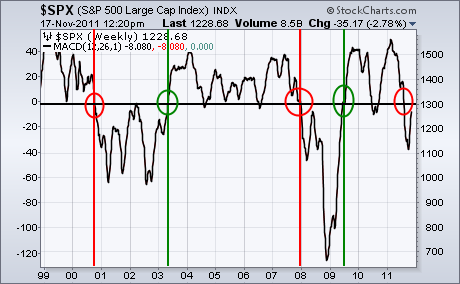
A number of bearish developments have emerged on the weekly chart for the Russell 2000 ETF (IWM). This weekly chart extends two and a half years to cover the long-term situation. First, the ETF broke support with a sharp decline in August and then exceeded the July 2009 trendline. Second, the subsequent bounce met resistance near broken support and the 61.80% retracement. This is what would be expected from a counter trend advance within a bigger downtrend. Third, RSI broke below 40 for the first time since the rally began 2009. The 50-60 zone now becomes resistance.
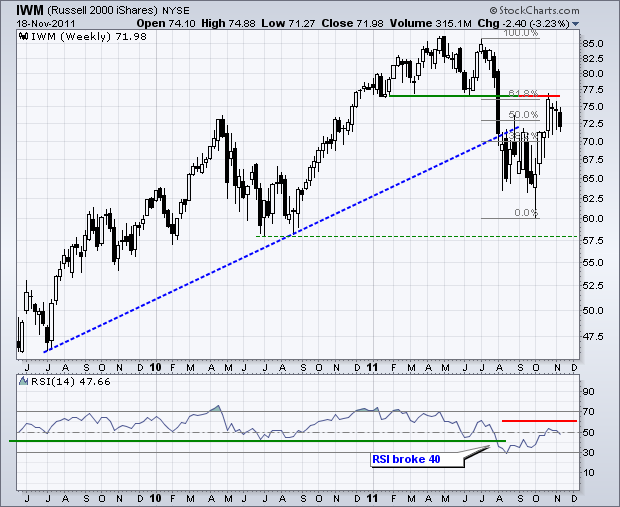
Click this image for a live chart.
Despite potentially bearish developments on long-term chart, IWM remains in an uptrend on the daily chart, which captures the medium-term trend. The next chart shows IWM breaking above its resistance zone with the late October surge. The ETF became quite overbought with this surge and then consolidated the last four weeks. The break from this consolidation holds the next key. An upside breakout would signal a continuation of the October advance and target a move to the summer highs. Conversely, a break below consolidation support would have medium and long term implications. First, resistance on the weekly chart would be reinforced. Second, a reversal of the October-November advance would signal a continuation of the long-term downtrend. This would target a move below the October low.
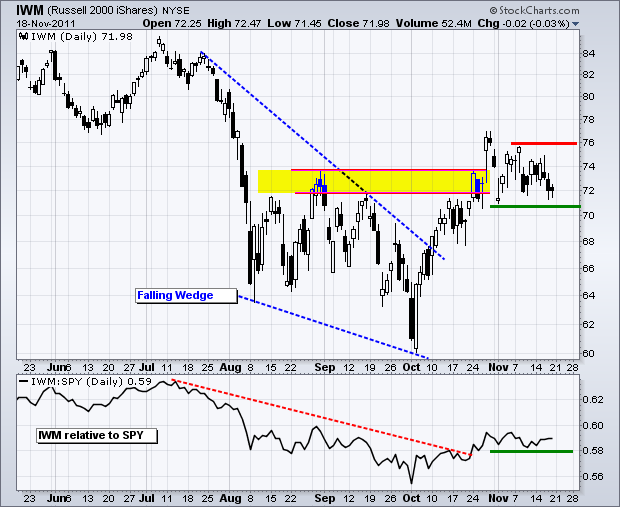
Click this image for a live chart.
Good trading,
Arthur Hill CMT
On Thursday the S&P 500 broke down from a triangle formation, which is a kind of continuation pattern. Continuation patterns are so named because, when the pattern ends, prices are normally expected to continue in the direction they were trending before the continuation pattern (consolidation) began. In this case, the breakdown was not what was expected, and puts a bearish shade on a picture that been bullish since the October low.
A positive aspect to the price breakdown is that a number of ultra-short-term indicators hit climactic oversold readings the same day. On the chart below we can see how these oversold spikes generally coincide with the start of rallies of at least short-term duration.

Climaxes are a sign of either initiation or exhaustion. An initiation climax signals that price will begin moving in the direction of the climax, while an exhaustion climax occurs at the end of a move. Immediately following a climax, prices can chop around for a day or two before the followthrough begins.
The question, of course, is what kind of initiation is this one? With an intermediate-term buy signal in effect, we look for a bullish interpretation, which would be that the breakdown was actually a shakeout, intended to turn people bearish just ahead of a rally. Unfortunately, we are still on a long-term sell signal, which means things could be about to get nasty again.
Another negative is that intermediate-term indicators (see chart below) are still overbought and need to move to at least the neutral zone. As you can see on the chart, this can happen without accompanying price deterioration about half the time.

Bottom Line: The market just failed a test by breaking down out of the triangle formation, but the technical damage is not serious, and a decline to the 1175 area to clear intermediate-term overbought conditions could be absorbed without major technical damage being done. On the other hand, if the ultra-short-term oversold spikes have produced sufficient internal compression, yesterday's breakdown could prove to be the final shakeout preceeding a new rally. In any case I view the recent decline as a correction within the rally that began in October.
OPTIONS MANIPULATIONby Tom Bowley | InvestEd Central For an options expiration week, volume was quite light. Any time volume is light, the threat of market manipulation grows. As we headed into last week, max pain suggested a potential 2.5%-3.5% move lower in equity prices, depending on the index. With hindsight now, we see the major indices fell in the 3.0%-4.0% range last week. Coincidence? I have my own personal feelings, so you be the judge. One stock that was DEEP in terms of in-the-money puts was Green Mountain Coffee (GMCR). Take a look at this chart BEFORE last week's options manipulation:
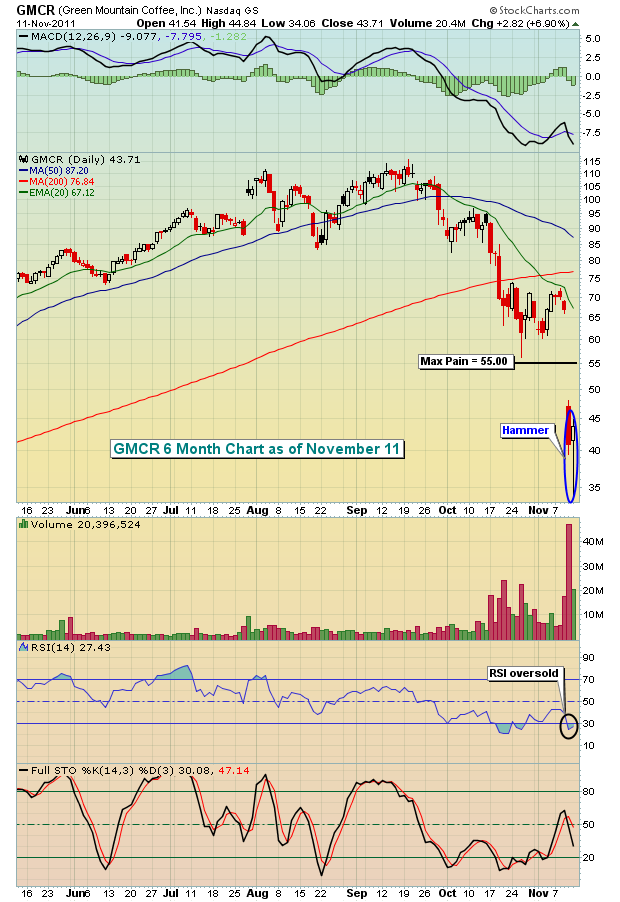
It was clearly in the market makers' best interest to steer prices higher, but who would have thought that max pain at 55.00 would be a possible destination? Well, here's how the week unfolded for GMCR longs:
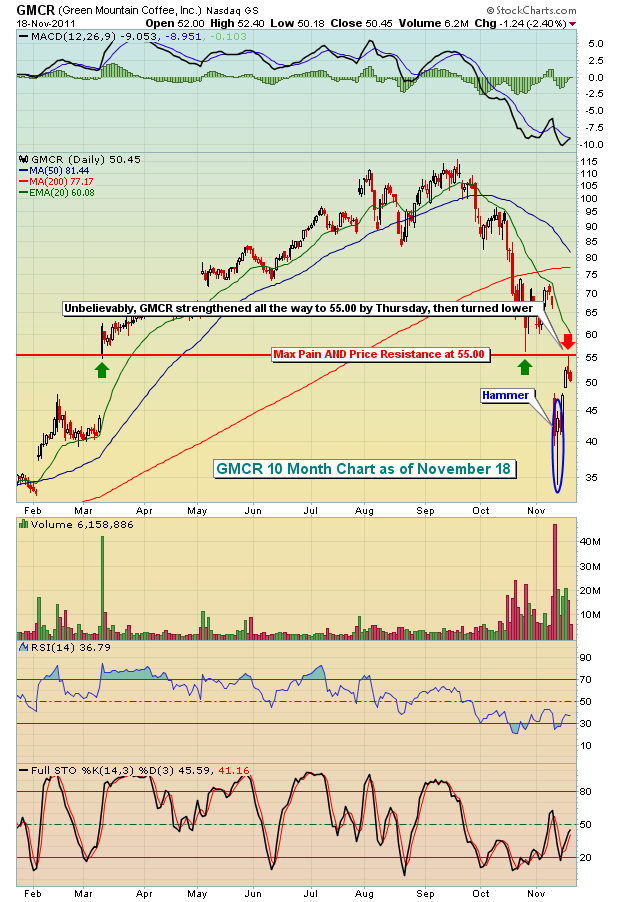
This was a perfect example of what happens during options expiration week. Obviously, they don't all work out like GMCR, but remaining on the short side heading into options expiration week was a HUGE risk. In addition to all the in-the-money puts, GMCR was oversold and had printed a reversing hammer candlestick on massive volume - not exactly the recipe for more gains on the short side. Notice also that 55.00 wasn't just the max pain number. It also was significant price resistance. Failure at that level was to be expected based on overhead supply.
The study of price support and resistance is the topic in this month's Online Traders Series event, scheduled for Tuesday, November 22, 2011 at 4:30pm EST. If you'd like to attend, please check out our holiday special offer to all ChartWatchers' readers HERE.
GMCR was a specific stock example of options manipulation, but I see this type of manipulation on the overall indices frequently, which is why I check out max pain heading into the third week of every calendar month (options expire the third Friday of each month).
Given the extent of last week's selling, there are a couple of charts that I'd pay particular attention to. Semiconductors, which looked great just a few days earlier, really struggled late in the week and are on the verge of a major breakdown. Take a look:
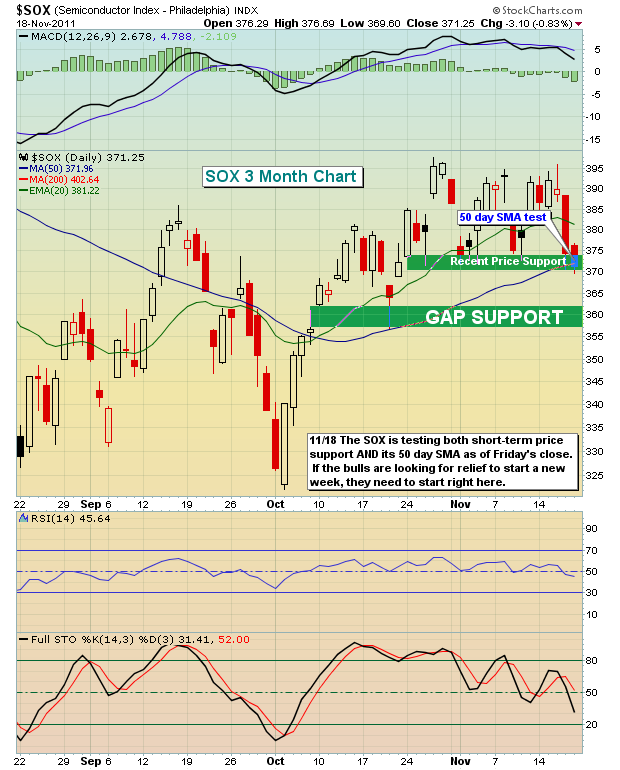
Finally, Europe continues to be the dog and the U.S. is the tail. If the major indices in Europe begin to lose major price support, it's very unlikely support will hold on the S&P 500. Here are the levels you need to be aware of on the German DAX and S&P 500 as a new trading week unfolds:

Happy Thanksgiving and happy trading!
BULLISH CONSOLIDATION FOR LIGHT CRUDEby Richard Rhodes | The Rhodes Report Over the past three months, we've seen the West Texas Intermediate Crude Oil futures ($WTIC) rise from low of $75/barrel to a high of $102/barrel, which is a rather large move in a very short period of time in what many consider to be a modest "risk-on" environment. Certainly the other commodity complexes have no responded in such a violently higher manner. This begs the question as to what is going on fundamentally and from a sentiment point-of-view. We can't find much that is fundamentally bullish; thus we must attribute this to simply more buying than selling and the ongoing Middle East "Spring" for lack of a better descriptor.

Technically speaking, we see the monthly $WTIC chart forming a rather large bullish consolidation that suggests in the months and years ahead that $WTIC will move to new highs above the $147.27 level. If trendline resistance is clearly violated on a $WTIC move above the $115 level - then we'll be rather confident that the highs will come into view rather quickly...with the possibility of a super spike higher.
Under this premise, we should note that many of the energy-related stocks are trading in bullish patterns not far off their lows and below their representative 200-day moving average levels. This presents an interesting opportunity for oil stocks to "catch-up" to the rise in $WTIC is a very violent manner. Be prepared.
Good luck and good trading,
Richard Rhodes